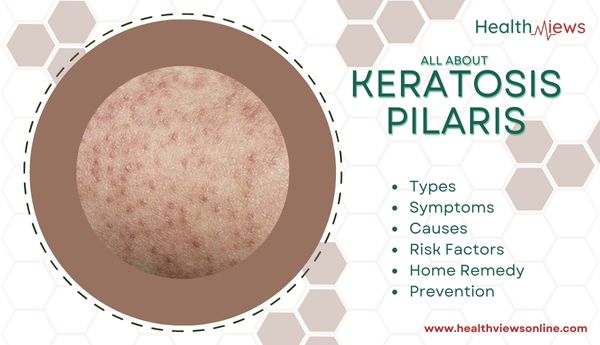What is Keratosis Pilaris?
Keratosis pilaris is a common, innocuous skin condition that causes tiny, hard bumps that feel like sandpaper on your skin. Dead skin cells that obstruct hair follicles generate these little bumps or pimples. They can sometimes appear red or brown.
“Chicken skin” is another name for keratosis pilaris. The majority of people with keratosis pilaris experience it for years before it eventually goes away on its own. Although treatments are available, it may take a while for your skin to improve.
Also Read: All About Ringworm: Types, Symptoms, Causes, Risk Factors, Home Remedy, Prevention
Rare variants of Keratosis Pilaris
It is a common skin disorder with rare forms and subtypes such as keratosis pilaris rubra, erythromelanosis follicularis faciei et colli, and the keratosis pilaris atrophicans spectrum.
- Keratosis pilaris rubra is a variant with more apparent erythema and, in some cases, more widespread skin involvement, but neither atrophy nor hyperpigmentation is seen in some other keratosis pilaris variants. Although rarely described, it appears to be a very common condition. Source
- Erythromelanosis follicularis faciei et colli is a rare disorder with an unknown cause that is distinguished by a triad of well-defined erythema, hyperpigmentation, and follicular papules. Source
- Keratosis pilaris atrophicans faciei is a rare form of keratosis pilaris characterized by scar-like follicular depressions and hair loss, particularly in the eyebrows. This causes atrophy and irreversible hair loss in the afflicted areas. Source
Causes
It occurs when the hair follicles become clogged with keratin, a material in the skin, hair, and nails.
Although the actual cause of keratin growth is unknown, it is believed that the disorder runs in families. Consequently, if your parents have it, you might too.
Since keratosis pilaris is not contagious, it cannot be transferred or acquired.
Risk Factors
It is more common in infants, preschoolers, children, and teenagers and frequently increases around puberty.
If someone in your family has keratosis pilaris, you are more likely to get it as well. Therefore, doctors and scientists believe that specific genetic features could be responsible.
If you have any of the following conditions, you are more likely to have keratosis pilaris:
- Light or fair skin.
- a few skin disorders, such as ichthyosis vulgaris or eczema.
- Asthma.
- Hypothyroidism.
- Cushing’s disease.
- Diabetes.
- Down syndrome.
- Obesity
Symptoms
The appearance of keratosis pilaris is the most noticeable sign of visible pimples on the skin resembling goosebumps or plucked chicken skin.
The bumps can appear anywhere on the skin where there are hair follicles, but never on the soles of your feet or the palms of your hands. It is more common on the upper arms and thighs. In severe cases, it might spread to the forearms and lower legs.
Other signs and symptoms of it include:
- Itchy, irritable skin
- Bumps that feel like sandpaper
- Slight pinkness or redness around bumps
- Bumps that vary in hue depending on skin tone (flesh-colored, white, red, pink, brown, or black or slightly pink or red around bumps)
Diagnosis
Your dermatologist will check your skin and pay particular attention to any areas that exhibit keratosis pilaris symptoms to diagnose this problem.
Treatment
Because this skin disease is not dangerous, there is no need to treat it.
If you are bothered by the itch, dryness, or look of your skin, therapy can help. A dermatologist can personalize a treatment strategy to your specific needs:
- Dead skin cells are removed from the skin’s surface using topical exfoliants. These consist of lotions with urea, alpha-hydroxy acid, lactic acid, or salicylic acid.
- Topical retinoids, which are related to vitamin A, aid in preventing hair follicle clogging.
- Laser treatment, which involves directing a laser at the skin, is sometimes used to treat extreme redness and inflammation. I
Home remedies
Although chicken skin or keratosis pilaris cannot be completely removed, the severity of the condition can be reduced and the red spots go away with the correct treatments. You must consider both internal and external solutions at home:
- Coconut Oil For It
- Essential Oils For It
- Eat the correct meals to help with this Variant
- Cod liver oil is frequently advised for overall and skin health.
- Glycolic Acid Treatment for this Variant
- Apple cider vinegar will eliminate dead skin cells and excess keratin that are causing skin bumps to form.
- Tea Tree Essential Oil
- Aloe vera
- Baking soda
- Argan oil
- Scrub
- lactic acid
- witch hazel
- oatmeal bath Source
Also Read: Health Benefits Of Aloe Vera: Medicinal Uses, Precaution & Side Effects
Prevention
Simple measures can help keep your skin comfortable:
- Keep your skin moist to mitigate the impact.
- Do not scratch or rub the pimples on your skin.
- Instead of hot water, bathe and shower in warm water.
- Keep your time in the water as short as possible.
- Try soap having oil or fat added.
- Apply heavy moisturizers liberally on the skin.
- Wear loose clothing (friction can irritate your skin).
Want to know about other skin disorders? Check out Skin Problems on Health Views Online.





